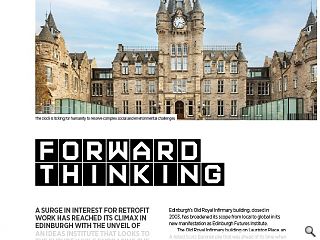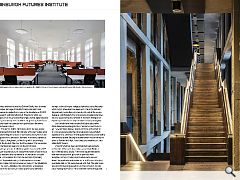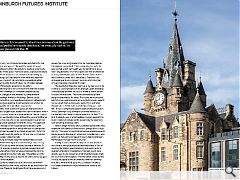Edinburgh Futures Institute: Forward Thinking
22 Jul 2024
A surge in interest for retrofit work has reached its climax in Edinburgh with the unveiling of an ideas institute that looks to the future while embracing the past. Urban Realm tours a timely intervention that looks to tackle the biggest issues facing humanity before the clock strikes midnight on climate change. Photography by Keith Hunter.
Edinburgh’s Old Royal Infirmary building, closed in 2003, has broadened its scope from local to global in its new manifestation as Edinburgh Futures Institute. The Old Royal Infirmary building on Lauriston Place, an A-listed Scots Baronial pile that was ahead of its time when built in 1879, finds itself thrust into the future once again as a base for researchers, students and university partners to develop ideas in fields ranging from artificial intelligence to philosophy.
The University of Edinburgh has chosen the landmark building to be the public face of its mission to tackle social inequality by bringing together the people and key stakeholders to develop new ideas and fresh approaches - while maintaining public access and doubling as a new home to both the Edinburgh International Book Festival and a leaner Architecture & Design Scotland.
A design team led by AtkinsRéalis, with architects Bennetts Associates and main contractor Balfour Beatty, has delivered the complex package of refurbishment, extensions and improvements needed to reimagine the hospital as a 20,000 sqm research and innovation hub. At pains to retain key features such as the precious Nightingale wards, repurposed as teaching and workspaces, as well as the giant flagstone floors, the design team has painstakingly peeled back the layers of institutional neglect. At first glance, Edinburgh Futures Institute may appear the quintessential Scotch Baronial pile, with only modest glass additions hinting at the scale of work conducted within.
In the driving seat of this process is Bennetts Associates, a practice with 21 years of experience of working with the university, notably the lauded Poterrow Building, seeing off a succession of architectural big beasts to win the commission. Bearing the scars of a lifetime spent in service of the NHS the much-abused structure had suffered years of ignominious ad-hoc additions and alterations at the hands of the health service, unshackled as it is from the red tape of planning consent. Suspended ceilings, ill-advised accretions and asbestos-ridden catacombs were just some of the tribulations facing the team. Ultimately, this proved to be a blessing in disguise as the tendency to cover up problems with false ceilings and walls helped safeguard priceless period features which might otherwise have been lost. One of the first and biggest tasks facing Bennetts was to strip out all the excess baggage, unfortunately, that process also revealed extensive dry rot, necessitating the removal of most soft fittings and explaining the decision to expose bare masonry throughout. Lost details have been restored including decorative stone finials representing thistle’s, shamrocks, and fleur-de-lys. New additions follow a simple concrete grid pattern to sit incongruously beside the old, an approach given fullest expression in a cavernous events space hollowed out beneath a new arrivals square. Belying its subterranean nature this top-lit space is flooded with light from clerestory windows and two glazed light towers.
Proud of what has been accomplished Rab Bennetts, co-founder of Bennetts Associates, gave Urban Realm a tour of the building, saying: “I think the square integrates well with the city and in general the planners were receptive. Historic Environment Scotland was nervous about the gatehouse and pushed us to justify demolition but eventually said ok. We were pleased with that. The gatehouse predated the building as part of a former school on the site called George Watson’s. It had a romantic classical style and was not very nice. It’s been dismantled and offered for sale to anyone who wants it.” Beneath the square sits a vast void hollowed out from the ground to create an acoustically separate events space. Framed by clearly expressed structural concrete the chamber is anchored to the old building by excavating a ‘pit’, exposing the stone walls and basement windows. This aesthetic extends to new additions within the main building itself, principally the infill glass between wards that extends upwards into the rafters. Stretching 150m from one end to the other the institute presented challenges of orientation compounded by quixotic changes in level, revealed by comprehensive BIM (Building Information Modelling).
Bennetts adds, “Accommodation punctures the elevations at both ends with enlarged glass openings, to aid navigation and anchor the building within Quartermile more generally.“ Uniting these connective spaces are impressive stone flagstones of giant scale, hidden from view for decades while in use as a hospital and now a signature feature. Bennetts noted: “You can see the old window grid and how we married that up with the new one. We set the concrete standing just off it so it’s a very clear expression of what it’s doing.” This approach carries through to new sculptural staircases serving the newly inserted upper floor line up with bays or open spaces to maximise the potential for chance encounters. “When it’s buzzing all these little booths are full, and you can’t help but meet people,” states Bennetts. Belying its historic nature the institute has been built with blended learning in mind with learning rooms hosting up to 30 students, joined by others logging in remotely. To that end, acoustics played an important consideration with sculptural baffles lining the hallways between fire doors to cut reverberant noise. Bennetts said: “It’s partitioned off for fire safety for very obvious reasons, we didn’t want a Glasgow School of Art situation.”
Attention to detail extends to decorative stone finials including thistle’s shamrocks, and fleur-de-lys, which adorn the roofscape. These can be glimpsed from the upper levels and ensure that a new wing inserted into the roofscape matches the original in every detail. “This is a new wing to match the previous half. which we thought was the right thing to do up here,” says Bennetts. “It’s fine to express the new and there are so many stone repairs, you can see it all over. These facades were covered in pipes, ducts and all sorts. There was lots of repointing and we’ve repaired the stone where they had smokers’ balconies chased into the wall.” The elevated vantage also opens up to the best view in the institute, a chance perspective of Edinburgh Castle, framed by a fortunate gap between two blocks as well as skyline details invisible from the street.
“The rooms and volumes up here are given character by the eaves. The trusses were concealed behind various walls and some were painted and some weren’t. We’ve just left them as they were.” Gesturing to a window Bennetts adds: “I think that’s a rebuilt wind tower, you can’t tell.” The air is compressed going through creating the suction effect. Edinburgh being a windy city it would work a lot of the time but I don’t know if it would work all of the time.” This lack of reliability sees a hybrid ventilation system augment the historic vents with climate control powered by the university’s central heating and power plant. Interior design work was also undertaken by Bennetts, who employed dark frames and bold colours giving a distinct visual identity. “The colour is important because we wanted people to feel immersed in this area of the building”, notes Bennetts, who points out that earthy oranges and browns help to distinguish the Meadows frontage from the city side.
Visiting on one of the wettest days of the year workmen were hard at work plugging a persistent leak ahead of the full opening, the institute was still ramping up to welcome a full quantum of students in September. Important guests have already been to visit, some from as far afield as Canada, which has its version of the hospital in Montreal which is to be turned into a public space by McGill University. More than anything else the University of Edinburgh has succeeded in making a 145-year-old landmark not just relevant but vital to all our futures.
|
|





